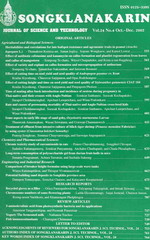ThaiScience
ThaiScience
SONGKLANAKARIN JOURNAL OF SCIENCE & TECHNOLOGY
Volume 42, No. 03, Month MAY, Year 2020, Pages 621 - 630
Geochemical indices and palynology comparison used for paleoproductivity and paleoredox conditions of the huai hin lat formation in part of loei-petchabun fold belt in central thailand
Boonnarong Arsairai, Qinglai Feng, Chongpan Chonglakmani, Akkhapun Wannakomol, Hathaichanok Vattanasak
Abstract Download PDF
Petrography and geochemistry analyzing Dat Yai section can describe paleoproductivity and past-redox condition. Paleoproductivity proxies consisted of AOM, phytoclast, TOC, excess SiO2, Ba/Al, and P/Al as high values through sections which similarly indicate high productivity. High productivity in Beds 3 and 27 showed lower peak TOC which is explained by poorer preservation. Lower productivity of Bed 18 showed a high TOC peak indicating good preservation. Paleoredox condition was evaluated using Ni/Co, U/Th, V/Cr, V/(V+Ni), Ni/V, and (Cu+Mo)/Zn. Values for V/(V+Ni) ranged from 0.67 to 0.85 exceeding the cutoff value of 0.46 for a reducing environment. The average value of V/Cr (2.07) exceeded 2.0 of anoxic. Bed 9 consisted of the highest peak of TOC that does not reflect the excellent preservation resulting from dominantly high paleoproductivity. Bed 21 exhibited lower productivity and lowest TOC which indicated a poverty-reducing effect. AOM and phytoclasts were supplied and kept in the benthic floor by extreme redox. Sediments became black shale which expelled oil and some gas.
Keywords
TOC, hydrocarbon, geochemistry, kerogen, petrography, Huai Hin Lat FormationSONGKLANAKARIN JOURNAL OF SCIENCE & TECHNOLOGY
Published by : Prince of Songkla University
Contributions welcome at : http://rdo.psu.ac.th
